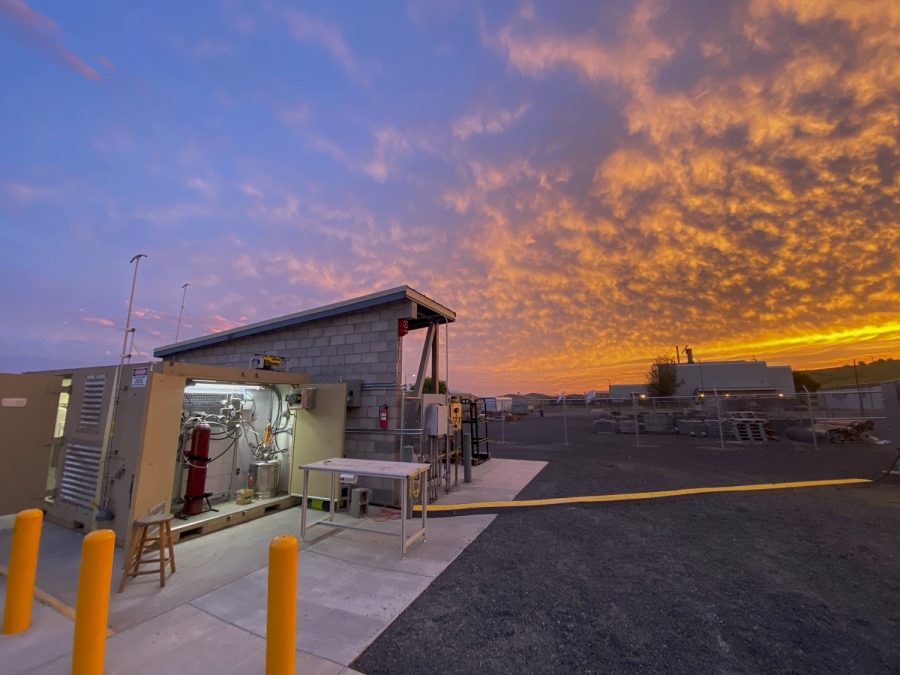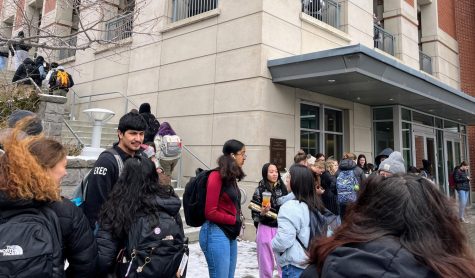WSU facility develops fuel for U.S. Army drones
Outdoor Research Facility run by students, faculty; collaboration with army includes designing tanks to store liquid hydrogen for drones
WSU’s Outdoor Research Facility is used exclusively for hydrogen testing. It is located in a quiet area on the Palouse where testing can be performed safely.
February 4, 2021
WSU is home to the only liquid hydrogen lab in U.S. academia, transforming hydrogen into a fuel source for U.S. Army surveillance and reconnaissance drones.
There is a lot of clean and renewable energy in Washington, said Jacob Leachman, director of the Hydrogen Properties for Energy Research Laboratory. Conducting hydrogen research is best done in the state.
WSU has one of the best power grid and aerospace programs in the country, he said.
Leachman founded the Outdoor Research Facility in 2010, which was fully constructed in January 2020. He said the facility houses the HYPER lab. It is used by WSU students and faculty to bring their innovative ideas to life.
The facility is used exclusively for hydrogen testing, he said. It is located in a quiet area on the Palouse where testing can be performed safely.
Leachman said the U.S. Army is currently funding the facility to build hydrogen liquefiers, which use hydrogen and electricity to transform hydrogen into fuel for drones.
Liquid hydrogen drones are used as monitoring devices, he said. They have been used to study polar bear populations in Alaska and help tuna fishermen track fish movement.
“It’s just an eye in the sky,” Leachman said.
The facility is working with the army to design and test different tanks to store liquid hydrogen for the drones. The main purpose of the drones is surveillance and reconnaissance, said Ian Richardson, Outdoor Research Facility manager.
The goal is to turn liquid hydrogen into gaseous hydrogen. This goes into a fuel cell, combines with oxygen and creates electricity and water vapor. The electricity is then used as an energy source for the drones.
Right now, a typical drone uses gasoline internal combustion engines, Richardson said. They are expensive, have frequent engine problems and are loud to use. The use of hydrogen as an alternative fuel source is a solution.
Hydrogen is more reliable than internal combustion engines, Leachman said. It enables the drones to have longer, quieter flights.
“Batteries are too heavy to get the flight times that [the army] is looking at,” Richardson said.
WSU faculty and staff are currently building a transportable liquid hydrogen fueling station, he said. Hydrogen is not commercially available, so the facility is making it in containerized systems.
“I can’t just go to a gas station and buy a jug of liquid hydrogen,” Richardson said. “We are making it ourselves.”
Innovative ideas are created every day, Leachman said. The facility is exclusively run by WSU faculty and students from a variety of majors. Students studying business, communications, material science and even music have brought their ideas to the research facility.
Leachman said a group of students recently found a solution to the removal of moon dust from astronaut suits, using liquid nitrogen to spray them off. It is like going through a car wash, he said.
A WSU flutist contributed to the research, using her sewing skills to create mini astronaut suits to put on dolls, he said. The suits are then dipped in ash collected from Mt. St. Helens to simulate moon dust. They are sprayed with liquid nitrogen to practice removing moon dust from the suits.
Leachman said the COVID-19 pandemic has not changed the amount of progress the facility has been making. The students and faculty are still using their time and energy efficiently. The only difference is that there are more sanitary and social distancing measures in place.
There have been some concerns about the safety of the facility, he said. Many people believe hydrogen is unsafe and are afraid of having the lab at WSU. However, he said hydrogen can be safer than many conventional fluids, like gasoline.
“The most dangerous thing that has ever happened was that somebody got a papercut on a piece of sheet metal,” Leachman said.
Richardson said he believes the facility is heading toward creating smaller-scale hydrogen liquefiers to be used in renewable energy farms or in offshore winter turbines. The facility is currently developing key technology to make that possible.


















Edwin Walker • Feb 7, 2021 at 9:18 pm
Interesting article. I graduated in 1966, so a lot of things have changed. The Daily Evergreen is still there. I’m really impressed by the large variety of projects in work at WSU, this is one I never knew existed. I’m even more impressed with the students and their accomplishments.
As I recall, its very difficult to even cool Hydrogen enough to liquify it, and storage would be a challenge. I know its used in space craft , and the tanks must be vented and kept super insulated to prevent expansion and bursting of the tank.
I believe that there is a lot of energy per pound in liquid Hydrogen, so if it is practical, and successful in this application, it will potentially find other uses as it becomes more practical to use and store.